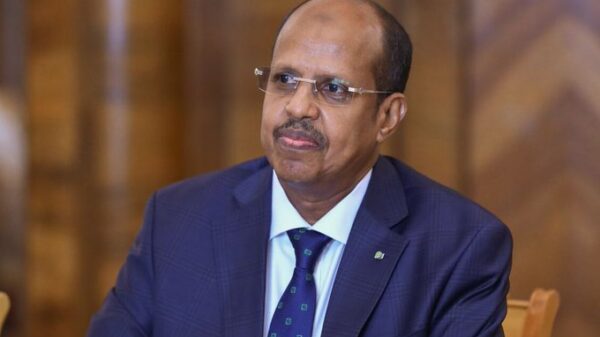
As a young Maasai moran, Jeremiah Kutanya, had sworn never to marry a girl who is not circumcised. Photo/ KEVIN GITAU
NAIROBI, Kenya, Jan 29 – As a young Maasai moran, Jeremiah Kutanya, had sworn never to marry a girl who is not circumcised.
He was determined to continue nurturing cultural practices he learnt from his father and grandfather during his transition to manhood.
It was very important for him to marry a girl who had undergone Female Genital Mutilation (FGM).
“The work of a moran is to continue the traditions. We were trained on how to perpetuate what our fathers and our forefathers were doing. Marrying a girl who is circumcised was our tradition and we in Maasai stick to our practices. I did not want to violate our culture.”
“That’s why I planned to marry a girl who is cut,” says the 26-year-old now a university graduate.
David Sayianka, a community elder spent most of his 63 years ensuring that no girl passed teenage without undergoing the cultural cut.
“I was very passionate and I was among the top crusaders of FGM. I never missed any single celebration of girls cut. I attended parties to celebrate.”
“I would never marry a woman who is not circumcised. I got a wife who is cut.”
Sayianka has four daughters.
Two of them underwent the outlawed cut whereas the others were lucky to escape the knife of agony.
Today, Kutanya’s and Sayianka’s thoughts on FGM have changed.
Thanks to the massive campaigns launched across the country to fight the dangerous cut. They now wander from corner to corner of the hot land of Magadi stopping those cutting girls and warning them of legal consequences should they make any attempts to cut girls.
At the age of 26, Kutanya would have been a father of several children and husband to many wives.
But education has changed his perspective of life and culture.
“I feel I am a young man. I don’t have to marry at this age. I will marry when I am ready. I will marry a girl who is not cut,” Kutanya explains.
His turning point was on the day he saw a young Maasai mother die while giving birth.
“During trainings by AMREF Kenya, I heard that FGM can cause death. But I still didn’t believe that.”
“It was until I witnessed such a case. There was a mother who was being rushed to hospital and because of obstruction of labour, the woman passed away.”
“That’s when I believed that seriously this practice can kill. It really shocked me and it made me think of campaigning against it,” he recalled during an interview with Capital FM News.
Kutanya is now the Executive Director of Enlighters Youth Institute in Magadi which comprises of Maasai morans committed to standing up against the girl cut.
Sayianka as well attended a series of FGM sensitisation workshops but he shrugged them off as lame excuses meant to frustrate the Maasai culture.
“I kept on wondering what their interest was on stopping our girls from getting the cut. They kept on saying it was bad, but I didn’t see it.”
It was only after watching a video demonstrating the gruesome process of removing the female genitalia from young girls that Sayianka vowed to start protecting girls.
“I couldn’t watch the entire video. I shut my eyes maybe half of the five minutes long video. It was painful to see the small girls screaming and blood oozing out, I almost cried as I watched the video,” Sayianka recalled.
“I didn’t think it was that awful. I thought it was only a small cut.”
He as well learnt that FGM leads to birth complications, can cause tumors in the genitalia and even lead to death due to over bleeding.
“Girls over bleed, they get wounds and tumors. We are now telling people the dangers of cutting girls. It is a dangerous taboo. Many people don’t know or don’t want to accept that our taboo is bad. So we really have to show them what we saw on that video.”
Oldoinyo-Nyokie Assistant Chief Joseph Kayioni explains that it is not easy for Maasai men to stand up against a culture that is still widely viewed as important in transition of girls to women or making of wives.
They are first viewed as betrayers of dreams of their fathers and forefathers.
Despite the resistance, Kayioni says having men taking the lead in the war against FGM is realising results. He says the number of girls undergoing the cut in Magadi has declined same way the number of girls dropping out of school has reduced.
The number of girls joining school has also increased compared to previous years when FGM was rampant.
“It’s not easy to tell Maasais not to cut their girls. But it doesn’t matter how long it will take but we can see many people can hear what we are saying and have stopped cutting their girls,” the Chief explained.
According to AMREF, in Kenya, the ratio of girls to boys in Oldonyo-Nyokie Primary School who sat for the 2015 Kenya Certificate of Primary Education was almost equal.
There were 21 girls and 25 boys.
Due to interventions of subjecting girls to the Alternative Rite of Passage, the number of girls staying in school has increased compared to previous years.
In the year 2008, there were only two girls in a class of 16 pupils.
“If we fight FGM, we will have our girls succeed in school and in life. But if we allow it to continue, our young girls will get married when they are only adolescents,” Kayioni advised.











































